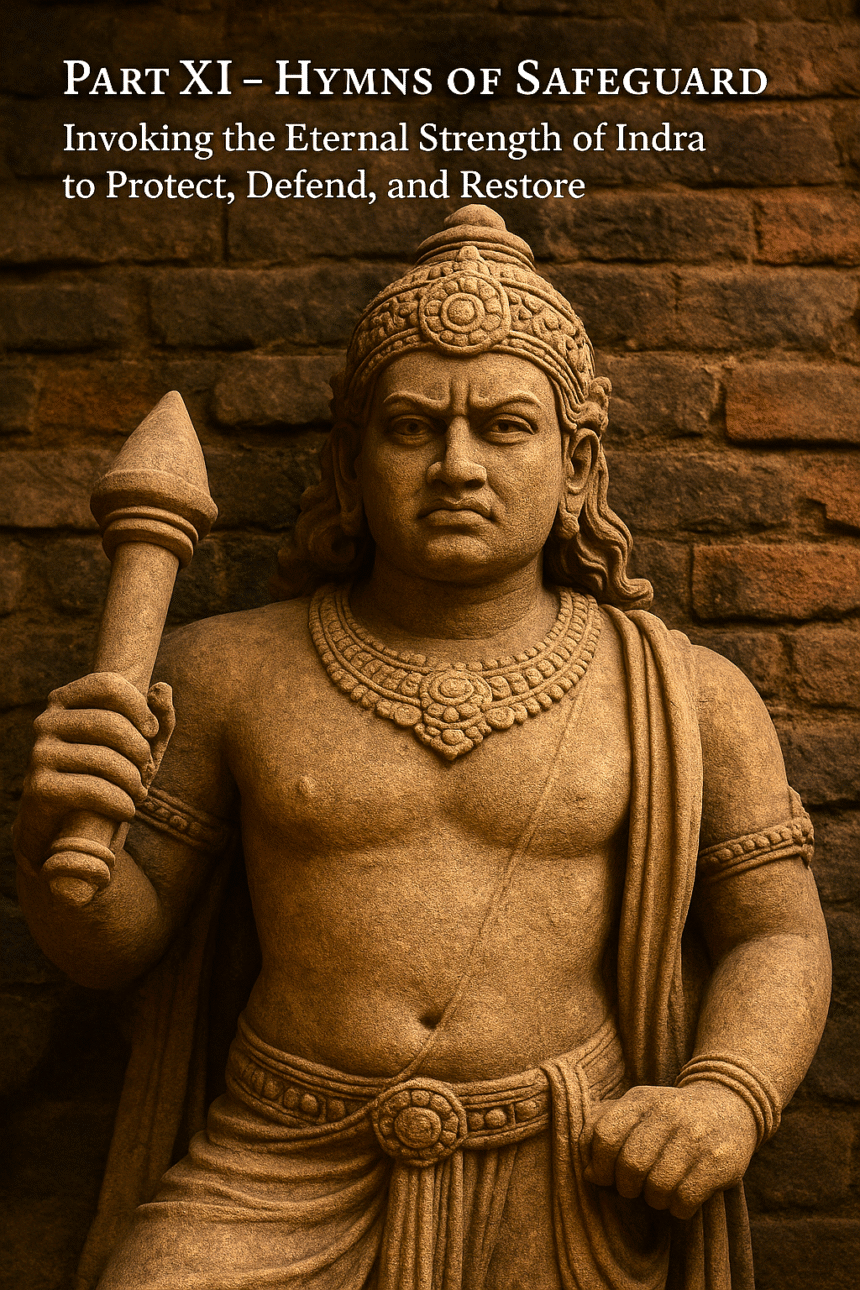Vedic Invocations of Power: Thunderbolt and the Eternal Hymns of Safeguard
Part XI – Hymns of Safeguard
Invoking the Eternal Strength of Indra to Protect, Defend, and Restore
Vedic Invocations of Power: A Living Arsenal
In our effort to equip Hindus with time-tested spiritual defenses rooted in Dharma, we present the next set of ṛcas from the Hindu Texts. The Rigveda is not merely a scripture of praise but a living armory of sound. These Vedic Invocations of Power are ancient mantras that function as weapons of spirit, designed to shield and to strike. In the previous blog, we followed Indra’s victories through the opening verses of Sukta 1.51. Now, we continue with deeper Vedic Invocations of Power—direct calls to Indra’s thunderbolt, his justice, and his role as protector of Dharma.
Here Indra’s power takes its most forceful form—breaking fortresses and releasing waters in a direct act of protection.
Vedic Invocations of Power — Rigveda 1.51.7–12
Rigveda 1.51.7
Sanskrit
त्वे विश्वा॒ तवि॑षी स॒ध्र्य॑ग्घि॒ता तव॒ राधः॑ सोमपी॒थाय॑ हर्षते ।
तव॒ वज्र॑श्चिकिते बा॒ह्वोर्हि॒तो वृ॒श्चा शत्रो॒रव॒ विश्वा॑नि॒ वृष्ण्या॑ ॥
Audio
Transliteration
tve viśvā taviṣī sadhryak hitā tava rādhaḥ soma-pīthāya harṣate ।
tava vajraḥ cikite bāhvoḥ hitaḥ vṛśca śatroḥ ava viśvāni vṛṣṇyā ॥
Translation
“All powers unite in you, Indra. Your gifts rejoice at the Soma drink. Your thunderbolt rests in your arms—strike and sever all the might of enemies.”
Explanation
Indra is invoked as the wielder of cosmic strength. The Vajra is identified directly as a weapon of defense, demanding enemy force be cut down.
Rigveda 1.51.8
Sanskrit
वि जा॑नी॒ह्यार्या॒न्ये च॒ दस्य॑वो ब॒र्हिष्म॑ते रंधया॒ शास॑दव्र॒तान् ।
शाकी॑ भव॒ यज॑मानस्य चोदि॒ता विश्वेत्ता ते॑ सध॒मादे॑षु चाकन ॥
Audio
Transliteration
vi jānīhi āryān ye ca dasyavaḥ barhiṣmate randhaya śāsad avratān ।
śākī bhava yajamānasya coditā viśve etā te sadha-mādeṣu cākana ॥
Translation
“Discern the Ārya and the Dasyu, subdue the law-breakers, O Indra. Be the strength of the sacrificer; let all your deeds be known at the sacred gathering.”
Explanation
Indra is here the guardian of cosmic law—upholding order (vrata) by protecting the righteous and suppressing violators.
This verse highlights another form of Vedic Invocation of Power—devotion as a weapon that empowers even the weak.
Rigveda 1.51.9
Sanskrit
अनु॑व्रताय रं॒धय॒न्नप॑व्रताना॒भूभि॒रिंद्रः॑ श्न॒थय॒न्नना॑भुवः ।
वृ॒द्धस्य॑ चि॒द्वर्ध॑तो॒ द्यामिन॑क्षतः॒ स्तवा॑नो व॒म्रो वि ज॑घान सं॒दिहः॑ ॥
Audio
Transliteration
anu-vratāya randhayan apa-vratān ā-bhūbhiḥ indraḥ śnathayan anābhuvaḥ ।
vṛddhasya cit vardhataḥ dyām inakṣataḥ stavānaḥ vamraḥ vi jaghāna sam-dihaḥ ॥
Translation
“Indra strengthens the law-followers and subdues the breakers of vows. He strikes down even the overbearing; by praise, even the small worshipper can fell the proud.”
Explanation
These Vedic Invocations of Power now pivot from justice to cosmic arrival—Indra’s might expanding beyond social order into the very fabric of heaven and earth.
Rigveda 1.51.10
Sanskrit
तक्ष॒द्यत्त॑ उ॒शना॒ सह॑सा॒ सहो॒ वि रोद॑सी म॒ज्मना॑ बाधते॒ शवः॑ ।
आ त्वा॒ वात॑स्य नृमणो मनो॒युज॒ आ पूर्य॑माणमवहन्न॒भि श्रवः॑ ॥
Audio
Transliteration
takṣat yat te uśanā sahasā sahaḥ vi rodasī majmanā bādhate śavaḥ ।
ā tvā vātasya nṛ-mano mano-yuja ā pūryamāṇam avahan abhi śravaḥ ॥
Translation
“When Ushanas forged your might, O Indra, your power filled heaven and earth. The steeds of Vata, yoked with thought, bore you swiftly, bringing glory.”
Explanation
Here Indra’s presence is cosmic, unstoppable, and carried by divine swiftness.
Here Indra’s power takes its most forceful form—breaking fortresses and releasing waters in a direct act of protection.
Rigveda 1.51.11
Sanskrit
मंदि॑ष्ट॒ यदु॒शने॑ का॒व्ये सचाँ॒ इंद्रो॑ वं॒कू वं॑कु॒तराधि॑ तिष्ठति ।
उ॒ग्रो य॒यिं निर॒पः स्रोत॑सासृज॒द्वि शुष्ण॑स्य दृंहि॒ता ऐ॑रय॒त्पुरः॑ ॥
Audio
Transliteration
mandiṣṭa yad uśane kāvye sacā indraḥ vaṅkū vaṅku-tarā adhi tiṣṭhati ।
ugraḥ yayim niḥ apaḥ srotasā asṛjat vi śuṣṇasya dṛṃhitāḥ airayat puraḥ ॥
Translation
“When Indra joined Ushanas Kāvya, he mounted the strong steeds. Fierce, he released the waters and shattered Shushna’s fortified cities.”
Explanation
Protection is direct—life-giving waters freed, enemy fortresses crushed.
Rigveda 1.51.12
Sanskrit
आ स्मा॒ रथं॑ वृष॒पाणे॑षु तिष्ठसि शार्या॒तस्य॒ प्रभृ॑ता॒ येषु॒ मंद॑से ।
इंद्र॒ यथा॑ सु॒तसो॑मेषु चा॒कनो॑ऽन॒र्वाणं॒ श्लोक॒मा रो॑हसे दि॒वि ॥
Audio
Transliteration
ā sma ratham vṛṣa-pāneṣu tiṣṭhasi śāryātasya prabhṛtā yeṣu mandase ।
indra yathā suta-someṣu cākano anarvāṇam ślokam ā rohase divi ॥
Translation
“You stand upon the chariot, drinking Soma offerings of Sharyata. O Indra, you delight in the pressed Soma and ascend with unstoppable glory.”
Explanation
The Sukta closes with Indra exalted through Soma, affirming his divine renewal as protector of devotees.
Reflections: The Vedic Invocations of Power and Awakening
This Sukta completes the arc of Indra’s protective might—ranging from slaying serpents and oppressors to discerning law from lawlessness and empowering even the smallest devotee. These Vedic Invocations of Power remind us that divine protection is both cosmic and personal. Through sound, intention, and devotion, these hymns provide a timeless arsenal for the defense of Dharma. They channel cosmic strength into human hands, offering protection against deception, chaos, and oppression. For practice, use these Vedic Invocations of Power as kṣatra-oriented japa—reciting with focus and discipline, invoking them as a shield rather than a weapon of aggression.
Feature Image: Click here to view the image.
Videos
Watch the short video for daily practice that primarily contains the Slokas
Download the Audio Track for practice and protection
Glossary of Terms
- Rigveda: The oldest of the four Vedas; a corpus of hymns (ṛcas) composed in Vedic Sanskrit and arranged for ritual recitation and invocation.
- Maṇḍala: A “book” or division within the Rigveda; Hymn 1.51 belongs to Maṇḍala 1.
- Sūkta: A hymn or collection of verses within a Maṇḍala; e.g., Rigveda 1.51 is a Sūkta to Indra.
- Ṛc / Ṛca (ऋच्): An individual verse (hymn-line) of the Rigveda; plural: ṛcas.
- Mantra: A sacred utterance or formula whose precise sound, meter, and meaning are used for spiritual effect, protection, or invocation.
- Vedic Invocations of Power: Your editorial term for Rigvedic protection hymns used as a living spiritual arsenal to shield, restore order, and counter hostile forces.
- Indra: Vedic deity; king of the gods and protector of cosmic order, famed for the thunderbolt (Vajra) and the slaying of obstructive forces.
- Vajra: Indra’s thunderbolt—mythic weapon symbolizing decisive, protective power that breaks obstacles and disperses darkness.
- Vṛtra: A serpent/dragon figure whose defeat by Indra releases the withheld waters and restores light—an archetype of breaking stagnation and oppression.
- Dasyu: In Vedic context, law-breaking or anti-ritual forces opposed to Dharma and sacred order; often the object of divine chastening.
- Ārya: One aligned with sacred order (vrata), ritual, and truth; frequently contrasted with Dasyu in Vedic hymns.
- Vrata: Sacred law, vow, or code of conduct upheld by the gods and practitioners; Indra protects those who keep it and restrains violators.
- Soma: Sacred oblation/pressing and its deity; offering whose exhilaration empowers the gods, frequently associated with Indra’s might and glory.
- Vāta: The wind deity; in RV 1.51.10, “steeds of Vāta” poetically carry Indra, signaling swift, cosmic arrival.
- Uśanas Kāvya (Ushanas Kāvya): A sage/poet (kavi) allied with Indra in several hymns; associated with forging, guidance, and inspired counsel.
- Śāryāta (Sharyata): A ritual patron/figure whose Soma offerings please Indra (RV 1.51.12); emblematic of the yajamāna who sustains rite and order.
- Yajamāna: The ritual sponsor/offerer who performs the sacrifice (yajña) and seeks divine protection and prosperity.
- Barhis / Barhiṣ: The sacred ritual grass laid for the sacrifice; “barhiṣmate” denotes one seated at the barhis (the sacrificer).
- Kṣatra: Sovereign/warrior power or protective authority; in practice, the disciplined, defensive aspect of spiritual strength.
- Kṣatra-oriented japa: Focused repetition of mantras with protective, duty-bound intent—invoking safeguarding force rather than aggression.
- Japa: Disciplined, rhythmic repetition of a mantra, often with a fixed count (e.g., 11, 21, 108), breath, and visualization.
- Adhikāra: Eligibility or qualification to undertake a practice; stresses inner readiness, purity, and responsible use of potent hymns.
- Dharma: The sustaining order—cosmic, ethical, and social—upheld by right action, truth, and ritual; the ground of protection in Vedic thought.
- Aṅgirases (Aṅgiras): A lineage of ancient seers invoked in many Rigvedic hymns; emblematic of inspired guardianship and discovery.
- Atri: A renowned ṛṣi (seer) celebrated in the Rigveda; often aided by Indra in overcoming obstacles.
- Kutsa: A heroic ally/sage figure supported by Indra against adversaries; cited as an example of divine-backed victory.
- Śuṣṇa (Shushna): A hostile figure/force opposed by Indra; associated with fortified strongholds that Indra breaks.
- Śambara (Shambara): A powerful adversary subdued with Indra’s aid, typifying the overthrow of oppressive citadels.
- Arbuda: A formidable foe trampled by Indra; symbolizes the crushing of entrenched obstruction.
- Pipru: An enemy whose strongholds Indra breaks; stands for hidden or fortified hostility.
- Ṛjiśvan (R̥jiśvan / Rjishvan): A devotee/ally aided by Indra in “dasyu-slaying” deeds; example of devotion empowered for protection.
- Dasyu-hatyā: “Slaying of the Dasyu”—a Vedic phrase for subduing lawless, anti-ritual forces to restore Dharma.
- Anarvāṇam: “Unstoppable/irresistible” (lit. “without a rival/hindrance”); used in praise of Indra’s ascending glory (RV 1.51.12).
- Sādhryak (sadhryák): “Together/alongside/in union”; in RV 1.51.7 indicates powers joined or aligned in Indra.
- Maṇḍala–Sūkta–Ṛc structure: The hierarchical arrangement of the Rigveda—books (maṇḍalas), hymns (sūktas), and verses (ṛcas)—governing citation like “RV 1.51.10.”
#Rigveda #Vedic #Indra #Mantra #HinduinfoPedia
#HymnsofSafeguard
Previous Blogs of the Series
- https://hinduinfopedia.org/civilization-under-siege-why-hindu-communities-face-an-existential-crisis/
- https://hinduinfopedia.org/crisis-documented-mathematical-evidence-of-systematic-hindu-elimination/
- https://hinduinfopedia.org/vedic-defense-mantras-rigvedas-protection-against-threats/
- https://hinduinfopedia.org/agni-suktas-for-protection-invoking-divine-fire-against-adharmic-forces/
- https://hinduinfopedia.org/indra-suktas-for-victory-invoking-the-divine-warrior-against-overwhelming-odds/
- https://hinduinfopedia.org/hymns-of-safeguard-an-ancient-armory-for-modern-crisis/
- https://hinduinfopedia.org/ashvini-kumar-suktas-for-divine-rescue-and-healing/
- https://hinduinfopedia.org/rigvedic-hymns-a-deeper-look-at-divine-protection/
- https://hinduinfopedia.org/vedic-defense-through-rigveda-richas-a-deeper-look-at-divine-protection/
- https://hinduinfopedia.org/mantras-for-defense-hardcore-rigvedic-protection-against-spiritual-disturbances/



Leave a Reply